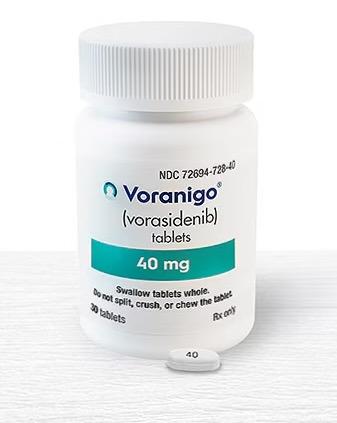Voranigo Dosage
Generic name: vorasidenib 10mg
Dosage form: tablet, film coated
Drug class: Miscellaneous antineoplastics
Medically reviewed by Drugs.com. Last updated on Apr 8, 2025.
Recommended Evaluation Before Initiating VORANIGO
Before initiating VORANIGO, evaluate blood chemistry and liver laboratory tests.
Patient Selection
Select patients with Grade 2 astrocytoma or oligodendroglioma for treatment with VORANIGO based on the presence of IDH1 or IDH2 mutations in tumor specimens.
Information on FDA-approved tests for detection of IDH1 or IDH2 mutations in Grade 2 astrocytoma or oligodendroglioma for selecting patients for treatment with VORANIGO is available at: https://www.fda.gov/CompanionDiagnostics.
Recommended Dosage and Administration
Recommended Dosage
Adult Patients
The recommended dosage of VORANIGO in adult patients is 40 mg orally once daily until disease progression or unacceptable toxicity.
Pediatric Patients 12 Years and Older
The recommended dosage of VORANIGO in pediatric patients 12 years and older is based on body weight:
- Patients weighing ≥40 kg: 40 mg orally once daily
- Patients weighing <40 kg: 20 mg orally once daily
Continue treatment with VORANIGO until disease progression or unacceptable toxicity.
Administration
Swallow VORANIGO tablets whole with water with or without food. Do not split, crush or chew tablets.
Dosage Modifications, Management and Monitoring for Adverse Reactions
The recommended VORANIGO dosage reductions for adverse reactions are provided in Table 1.
| Dosage Reduction | Recommended Dose and Schedule |
|---|---|
| Adult patients and Pediatric patients 12 years and older weighing at least 40 kg | |
| First | 20 mg once daily |
| Second | 10 mg once daily |
| Pediatric patients 12 years and older weighing less than 40 kg | |
| First | 10 mg once daily |
| Permanently discontinue VORANIGO in patients unable to tolerate 10 mg once daily. | |
The recommended management for adverse reactions and VORANIGO dosage modifications for adverse reactions are provided in Table 2.
| Adverse Reaction | Severity* | Management and Dosage Modifications |
|---|---|---|
| Abbreviations: ALT = Alanine aminotransferase; AST = Aspartate aminotransferase; ULN = Upper limit of normal | ||
|
||
| Hepatotoxicity (Elevation of ALT or AST) |
Grade 1 ALT or AST increase >ULN to 3 × ULN without concurrent total bilirubin >2 × ULN |
Continue VORANIGO at current dose. Monitor liver laboratory tests weekly until recovery to <Grade 1. |
| Grade 2 ALT or AST >3 to 5 × ULN without concurrent total bilirubin >2 × ULN |
First Occurrence: Withhold VORANIGO until recovery to ≤Grade 1 or baseline.
|
|
| Grade 3 ALT or AST >5 to 20 × ULN without concurrent total bilirubin >2 × ULN |
First Occurrence: Withhold VORANIGO until recovery to ≤Grade 1 or baseline.
|
|
| Grade 2 or 3 Any ALT or AST >3 to 20 × ULN with concurrent total bilirubin >2 × ULN |
First Occurrence: Withhold VORANIGO until recovery to ≤Grade 1 or baseline.
|
|
| Grade 4 Any ALT or AST >20 × ULN |
Permanently discontinue VORANIGO. | |
| Other Adverse Reactions |
Grade 3 | First Occurrence: Withhold VORANIGO until recovery to ≤Grade 1 or baseline.
|
| Grade 4 | Permanently discontinue VORANIGO. | |
More about Voranigo (vorasidenib)
- Check interactions
- Compare alternatives
- Pricing & coupons
- Reviews (1)
- Drug images
- Side effects
- During pregnancy
- FDA approval history
- Drug class: miscellaneous antineoplastics
- En español
Patient resources
Professional resources
Related treatment guides
See also:
Further information
Always consult your healthcare provider to ensure the information displayed on this page applies to your personal circumstances.


